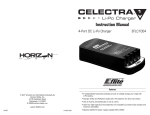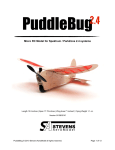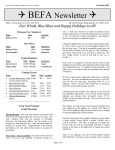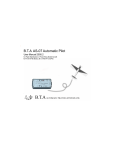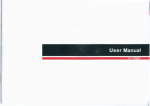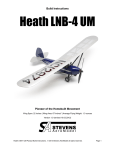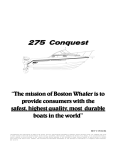Download Ember 2 - HobbyTown
Transcript
ParkZone® products are distributed exclusively by Horizon Hobby, Inc. 4105 Fieldstone Road Champaign, IL 61822 © 2008 Horizon Hobby, Inc. Horizon Hobby UK Units 1-4, Ployters Road Staple Tye Harlow, Essex CM187NS United Kingdom Horizon Hobby Deutschland GmbH Otto Hahn Str. 9a 25337 Elmshorn Germany Multiple Patents Pending DSM and DSM2 are trademarks or registered trademarks of Horizon Hobby, Inc. The Spektrum trademark is used with permission of Bachmann Industries, Inc. www.parkzone.com 12353.1 RTF Instruction Manual MICRO FLYERS, MAXIMUM FUN. Transmitter: P KZ 4-channel with Spektrum 2.4GHz DSM2 technology Battery: 3.7V 70mAh Li-Po Wingspan: 16.5 in (420mm) Length: 13.25 in (335mm) 2 Flying Weight: 0.7 oz (20 g) Ember™ 2 RTF Introduction Congratulations on your purchase of the ParkZone® Ember 2 RTF airplane. ParkZone’s Etomic™ family of innovative ultra-micro flyers makes micro flight a reality for everyone. Proportional, multi-channel, 2.4GHz Spektrum™ DSM2™ radio technology provides precise control for amazing, ready-to-fly indoor fun. Your Ember 2 comes pre-assembled with everything needed to get you in the air—all in one box. You only need to charge the flight battery prior to your first flight. In as little as 30 minutes, you can be ready to fly. This means you can spend your time refining your flying instead of your building skills. Your ParkZone Ember 2 will allow you to perform many aerobatic maneuvers, all in an area the size of half a basketball court. We at ParkZone are committed to giving you the most enjoyable flight experience possible. In order to have a safe and successful flight, we ask that you do not fly until you have read these instructions thoroughly. To learn more about DSM2 radio technology, and how to get the most of your Ember 2 transmitter, please visit www.bindnfly.com Your Ember 2 features the latest in ultra sub-micro technology, including a 2.4GHz Spektrum DSM2 fully proportional 3–channel radio system with full control of throttle, rudder and elevator. Your Ember 2 also comes complete with the latest in lightweight electronic speed control technology, two linear servos, a 3.7V 70mAh Li-Po flight battery and a convenient charger. 1 Warning Though your ParkZone Ember 2 comes ready to fly, this aircraft is for experienced RC pilots only and is not a toy. It can cause serious bodily harm and damage to property. FCC Statement This device complies with part 15 of the FCC rules. Operation is subject to the following two conditions: (1) This device may not cause harmful interference, and (2) this device must accept any interference received, including interference that may cause undesired operation. Caution Changes or modifications not expressly approved by the party responsible for compliance could void the user’s authority to operate the equipment. Instructions for Disposal of WEEE by Users in the European Union This product must not be disposed of with other waste. Instead, it is the user’s responsibility to dispose of their waste equipment by handing it over to a designated collections point for the recycling of waste electrical and electronic equipment. The separate collection and recycling of your waste equipment at the time of disposal will help to conserve natural resources and ensure that it is recycled in a manner that protects human health and the environment. For more information about where you can drop off your waste equipment for recycling, please contact your local city office, your household waste disposal service or where you purchased the product. This product contains a radio transmitter with wireless technology which has been tested and found to be compliant with the applicable regulations governing a radio transmitter in the 2.400 GHz to 2.4835 GHz frequency range. The associated regulatory agencies of the following countries recognize the noted certifications for this product as authorized for sale and use: Austria Belgium Canada Denmark France Finland Germany Italy Netherlands Spain Sweden UK USA 2 Step 1 – Charging the Aircraft Battery It is important that you only charge the included 3.7V 70mAh Li-Po battery (PKZ3001) with the included 1S 3.7V DC Li-Po Charger (PKZ3240). Attempting to charge the battery using another Li-Po charger or non-Li-Po compatible charger could result in serious damage. Please familiarize yourself thoroughly with the Battery Warnings and Guidelines section before continuing. To charge your ParkZone 3.7V 70mAh battery: 1. Install four of the included AA batteries in the charger base, noting proper polarity. 2. Slide the battery into the charge slot on the charger. 3. Gently press the battery into the charging jack in the bottom of the slot. The LED light on the base will turn solid red. 4. A nearly depleted battery will charge in approximately 20 minutes. 5. As the battery nears fully charged, the LED will begin to blink. When fully charged, the LED will blink once every 20 seconds. 6. You can expect to be able to charge the flight battery about 15–20 times before it will become necessary to replace the four AA batteries. Replacing with alkaline batteries will provide more charge cycles. Note: The Li-Po battery included with your Ember 2 will arrive partially charged. For this reason the initial charge may only take 10–15 minutes. 3 Step 2 – Functional Tests Installing the Transmitter Batteries Your ParkZone Ember 2 aircraft comes with a fully proportional 4+ channel radio system that includes digital trims. 1. Insert the 4 AA batteries that are included with the package into the transmitter. 2. Turn the switch on to ensure the batteries have been installed correctly. When the batteries are installed correctly, the LED on the transmitter should glow brightly. When the transmitter makes a repeated “beep” sound, it is time to replace the transmitter batteries. Installing the Landing Gear Attach the main landing gear by sliding the gear into the lower slot located on the front wing mount. 4 Installing the Flight Battery Once the Li-Po battery has been fully charged, it’s ready to be installed in the Ember 2. Install the battery in the Ember 2 by pressing it to the battery tray with the label facing downward and the connector oriented toward the back of the airplane. Note: Be sure to press the battery against the battery tray so the battery is secured by the hook and loop material. 5 Transmitter Control Identification Note: Each time before you fly you should ALWAYS turn the transmitter on before connecting the flight battery to the ESC unit. After each flight, be sure that you always disconnect the flight battery from the ESC unit before powering the transmitter off. Mode 2 Rudder/Throttle Functions Rudder Trim Buttons Throtlle Trim Buttons Aileron/Elevator Functions Aileron Trim Buttons Elevator Trim Buttons Mode 1 Rudder/Elevator Functions Rudder Trim Buttons Elevator Trim Buttons Aileron/Throttle Functions Aileron Trim Buttons Throttle Trim Buttons 6 Flight Control Test Warning: Keep everything clear of the propeller before starting the control test in the event that you accidentally turn on the motor. 1. Be certain that the throttle stick is down in the “Off” position. 2. Turn the transmitter on first and lower the throttle stick completely. Then, plug the battery into the battery lead of the ESC unit. Note: The connectors on the battery and battery lead are keyed to prevent reverse polarity connection. However, if you force them together in the wrong orientation and with the wrong polarity it is still possible to damage the battery and/or ESC unit. 3. Move the aileron stick left and right to check yaw control. The rudder should move to the left when the stick is pushed left and the rudder should move to the right when the stick is pushed right when viewing the Ember 2 from the back. Shown with aileron stick pushed to the left. Shown with aileron stick pushed to the right. Note: For most aircraft, the aileron stick is used for primary turning control. For the Ember 2, the rudder provides turning control and is therefore commanded by the aileron stick. 4. Move the elevator stick on the transmitter forward and aft to check elevator pitch control. When the stick is pushed forward, the elevator should move down when viewing the Ember 2 from the back. 7 5. With the elevator stick pulled back, the elevator should move upward. If at any time during the test the controls respond in the opposite direction, it may be necessary to reverse/change the direction of operation of the flight controls. Please see the section labeled Reversing Flight Controls located in the back of this manual. Note: It is very important to make sure that the control surfaces (rudder and elevator) are at 0 degrees, or neutral, when the surface control sticks are centered. 8 Making Adjustments to the Control Surfaces 1. Any changes necessary to bring both the rudder and elevator to neutral (zero degrees) when the right transmitter stick is centered should be possible using the digital trim buttons. 2. If you find this is not the case, do not fly until this has been corrected. 3. If corrections are needed, you may have to adjust the length of the pushrod by gently stretching or pinching the bend in the control wire as necessary. You can also achieve more control by changing the hole on the control horn that the pushrod connects to. We suggest you fly it first as it comes from the factory and then only move “in” one hole at a time. Motor Test 1. Make sure the throttle stick is down in the “Off” position. 2. Turn on the transmitter. 3. Plug the flight battery into the white lead in the fuselage. This must be done carefully to avoid accidentally reversing the polarity and causing damage to the ESC and battery. 4. Secure the flight battery. Gently press the battery pack against the hook and loop material on the underside of the fuselage. 5. Advance the throttle forward and the propeller should spin at a high speed. Caution: Make sure that you keep everything away from the propeller at all times. 9 You may notice there is quite a bit of down thrust when looking at the prop/prop shaft. This is intentional and is not a sign of damage. Adult Supervision Required Warning: Keep everything clear of the propeller and hold the plane securely. A moving propeller can cause severe injury. Step 3 – Range Test You will need two people to perform the range test: one to hold the plane and the other to give transmitter input. Warning: The person holding the plane should hold it in a way that prevents the propeller from coming into contact with any part of their clothing or body. 1. One person holds the transmitter while the other person walks 30 paces away with the airplane. 2. Be sure the throttle is in the “Off” position. 3. Turn the transmitter on. 4. Plug the airplane battery into the fuselage. 5. As soon as the throttle is advanced, the propeller should spin quickly. 6. As the first person moves the transmitter controls, the other person watches to ensure the airplane’s motor and tail controls operate smoothly. 10 Step 4 – Flying your Ember 2 Selecting a Flying Site Always choose a wide-open space for flying your ParkZone Ember 2. It is ideal for you to fly in an indoor location with a floor area of 40’x40’ and a minimum ceiling height of 20 feet. We suggest that first flights are done in a larger area, such as a basketball court or gymnasium. If you choose to make your flights outdoors, the conditions MUST be COMPLETELY CALM. The Ember 2 weighs less than 1 ounce and can easily be blown away. If you choose to fly outdoors, remember to always keep the plane upwind from you to avoid flyaways. Make certain that you do not fly near trees, buildings or other areas that can restrict your view or interfere with your flying. Seek Assistance from an Experienced Radio Control Pilot VERY IMPORTANT The 3-channel control system is designed for the experienced radio control pilot and is not intended for the first time flier. It is best to have HobbyZone Zone 2 experience. First-time pilots of the ParkZone Ember 2 should seek the assistance of an experienced RC pilot. Crash damage is not covered under the warranty. Step 5 – Hand Launching the Ember 2 1. Make certain that the aircraft battery is fully charged. 2. Turn on the transmitter. 3. Plug in the aircraft battery. 4. Test the motor and surface controls. 5. While holding the transmitter in one hand, push the throttle stick to full throttle (up) with your thumb. 6.Launch using light force. Keep the wings level. Do not throw it up or down. Point it level (parallel) with the ground when releasing. 11 Step 6 – Runway Takeoff 1. Prior to attempting a runway takeoff, you should have had several successful flights of hand launching the Ember 2. 2. Make certain the aircraft battery is fully charged. 3. Turn on the transmitter. 4. Plug in the aircraft battery. 5. Stand behind the Ember 2. Make certain you are on a smooth surface such as concrete or wood. 6. Apply full throttle and adjust the left stick so that you keep your Ember 2 on its intended path. 7. If the battery is fully charged, you should be able to lift off the ground in a few feet. As you notice the back of the plane beginning to lift a bit off the ground, apply some “up” elevator by pulling back on the right stick. Do not give too much “up” elevator, or you can cause the airplane to enter into a stall. 12 Step 7 – Flying 1. After launching, your Ember 2 will climb at full throttle. Keep the throttle full on until you have reached a safe altitude. At this same time, make sure that you are continuing to keep the airplane directed on its intended path. 2. Make right and left adjustments as necessary to keep the plane headed on its intended path. After you have reached 4-6 feet of altitude, you can begin to make the directional changes that you desire. 3. Remember—the Ember 2 is a small, lightweight aircraft. Do not allow the plane to get too far away from you. When the plane is farther away from you it is harder to see and could cause you to lose orientation. 4. Avoid holding the stick full right or left for more than two seconds, as this will cause the plane to enter a spiral and could threaten your Ember 2. 5. Do not try to climb too fast by pulling all the way back on the stick (up elevator), or your plane may enter into a stall. Instead, climb by giving small amounts of elevator. 6. Damage/bends to the wings or tail can greatly affect flight control. Repair or replace the damaged parts immediately. Sharp Turns In order to make a sharper turn, move the stick in the desired direction and add some up elevator (pull back on the stick). The plane will make a sharper banking turn. Note: With the throttle set at low or off (gliding), the plane will not turn as fast as when you are flying at or near full throttle. Rudder Trim If the model wants to constantly turn one direction, use the digital trim buttons to correct. Your Ember 2 should fly straight with the control stick at neutral. Always make trim changes in one-click intervals. 13 Step 8 – Throttle Adjustment 1. Climb to an altitude of 6-12 feet with full throttle. 2. To achieve and maintain a level “cruising” altitude, reduce the power by moving the throttle stick down to approximately 50%. The throttle stick is proportional, so you can add or reduce throttle in small increments as needed to maintain the desired altitude. 3. To reduce altitude, reduce throttle. 4. To increase altitude, increase throttle. Step 9 – Using Elevator Your Ember 2 is equipped with a third channel for elevator (pitch control). Pulling back on the stick provides up elevator. This allows for shorter takeoffs, better flares for landing, better climb rates and more effective turns. Pulling back too far on the elevator, however, will cause the airplane to enter a stall, causing the nose of the airplane to drop. To avoid crashing from a stall, always maintain enough altitude to recover. Just after a stall has occurred, the nose of the airplane will fall and the plane will look like it is diving. To pull out of a stall, simply pull back slowly on the elevator stick once your Ember 2 has built up airspeed. Remember, pulling back too quickly or for too long will once again cause the airplane to enter a stall. Effectively avoiding and recovering from stalls requires experience. Always seek the help of an experienced radio control pilot if you are not familiar with pitch control. Failure to do so could result in a crash and significant damage to your airplane. Elevator Trim If the Ember 2 wants to go up or down, use the elevator digital trim buttons next to the control stick to correct. The model should fly straight with the control stick at neutral and should have a steady, shallow climb at full throttle. 14 Step 10 – Landing Your Ember 2 When you begin to notice that your Ember 2 no longer climbs well under full power (normally after approximately 10-15 minutes), the battery is getting low and it is time to land. Bring in your aircraft toward the desired landing spot. Gradually reduce throttle (as well as giving a small amount of down elevator if you choose) to reach an altitude of approximately 4 feet. At this point, reduce even more throttle and your Ember 2 should glide in softly for a landing. Note: Your Ember 2 should be landed on a smooth surface (such as concrete or wood) so that the landing gear can work effectively. Expert Tip: As you get better and more experienced at flying, try adding a bit of “up” elevator just prior to landing to “flare” the plane. With some practice, your landings should become smooth and on target. Warning: Do not attempt to catch the airplane or injury may occur. Remember, there is a spinning propeller on the front of the plane that can cause injury! Also, remember to cut power to the motor right before you land to prevent damage to the propeller. 15 Reference Information Binding process The 2.4GHz DSM2 receiver in the Ember 2 uses a unique binding operation to link your transmitter with your receiver. Please note that your radio system has been bound for you already. Should you need to replace a transmitter or your aircraft, you will need to perform the binding process as detailed below. When using a DSM2 transmitter that is a different design than the Ember 2 transmitter, please refer to your transmitter’s manual for detailed binding instructions to be used in step 4 below. Confirm that ATV travels on your DSM2 transmitter are not exceeding 100% prior to binding your transmitter to the Ember 2. 1. Confirm that the flight battery is fully charged. 2. Confirm that the flight battery is disconnected from the receiver/ ESC unit and the transmitter is turned off. 3. Plug the flight battery into the receiver/ESC unit. After 5 seconds the LED on the receiver/ESC unit will begin flashing. 4. After verifying that the LED is flashing on the receiver/ESC unit, turn the transmitter power on while pressing in on the left stick. (You will here a ‘click’ when you press on the end of the stick.) Release the stick. 5. If you entered bind mode correctly, you will see a solid LED approximately 5-10 seconds later on the receiver/ESC unit. You should now be bound to the transmitter and have full control and function. Additional Smartbind™ Information Prior to each flight, you should ensure that you power on your transmitter and wait about 5 seconds before you plug in the flight battery into the receiver/ESC unit. Doing this allows time for the transmitter to scan and secure two open frequencies. If the flight battery is plugged in too quickly and the link is missed, it may cause the receiver to inadvertently enter bind mode. If this occurs simply leave the transmitter on and then disconnect and reconnect receiver power (flight battery). Should you encounter any problems, repeat the binding process again. If problems continue, call the Horizon Support Team at 1-877-504-0233. 16 Reversing Flight Controls Should the Ember 2’s electronic components be used in another aircraft, you may find it necessary to reverse the operation of flight control surfaces. Reversing the rudder and aileron operation can be accomplished by following the steps below: 1. Be certain that the battery is unplugged from the aircraft and the transmitter is turned off. 2. Push down on the digital trim button for the surface you would like to reverse. a. Top elevator trim button – elevator normal b. Bottom elevator trim button – elevator reverse c. Left rudder trim button – rudder normal d. Right rudder trim button – rudder reverse 3. Continue holding the desired digital trim button down and turn the transmitter on. 4. Hold the digital trim buttons down for approximately five seconds until tones are heard, confirming the selection. 5. Connect the flight battery and complete the flight control test, confirming that all surfaces are operating in the correct direction. Center of Gravity Location It is very important to confirm the ParkZone Ember 2 is properly balanced prior to flying. The Ember 2 should balance at 37mm (+/- 2mm) behind the leading edge of the wing with the battery tray centered. Replacing the Prop Shaft You may find that you need to replace the prop shaft in the gearbox should it become damaged. To replace the prop shaft: 1. Gently grasp the white nylon nut located at the back of the prop shaft to prevent it from turning. 2. While holding the nylon nut, rotate the spur gear in a clockwise direction. The prop shaft will thread out of the nut. 3. Gently pull on the spur gear and prop shaft will slide out of the gear box. 4. Thread the prop and spinner on to the new prop shaft by holding the spur gear and turning the prop in a clockwise direction. 17 5. Slide the new prop shaft back into the gear box. 6. Place the nylon nut on the back of the prop shaft. Spin the prop and spur gear in a counter-clockwise direction. The nylon nut will thread onto the prop shaft. 7. While holding the nylon nut in place, gently turn the spur gear counter-clockwise to ensure the nut is snug. Transmitter Dual Rate Function The ParkZone 4+ channel 2.4GHz DSM2 transmitter included with the Ember 2 features dual rate capability. The default setting is high rate. To access the low rate function, simply press IN on the right gimbal. The LED light on the transmitter face will begin to blink, alerting you that the transmitter is on low rate. To return to high rate, simply push in again on the right gimbal. Increasing control throws As you become more comfortable with flying the Ember 2, you may wish to increase the control throws for even more maneuverability. To increase the control throw, gently remove the pushrod from the control horn. It is recommended to increase control throw by installing the pushrod in closer to the surface one hole position at a time until you reach the desired control throw. 18 Warranty Period: Exclusive Warranty- Horizon Hobby, Inc., (Horizon) warranties that the Products purchased (the “Product”) will be free from defects in materials and workmanship at the date of purchase by the Purchaser. Limited Warranty (a) This warranty is limited to the original Purchaser (“Purchaser”) and is not transferable. REPAIR OR REPLACEMENT AS PROVIDED UNDER THIS WARRANTY IS THE EXCLUSIVE REMEDY OF THE PURCHASER. This warranty covers only those Products purchased from an authorized Horizon dealer. Third party transactions are not covered by this warranty. Proof of purchase is required for warranty claims. Further, Horizon reserves the right to change or modify this warranty without notice and disclaims all other warranties, express or implied. (b) Limitations- HORIZON MAKES NO WARRANTY OR REPRESENTATION, EXPRESS OR IMPLIED, ABOUT NON-INFRINGEMENT, MERCHANTABILITY OR FITNESS FOR A PARTICULAR PURPOSE OF THE PRODUCT. THE PURCHASER ACKNOWLEDGES THAT THEY ALONE HAVE DETERMINED THAT THE PRODUCT WILL SUITABLY MEET THE REQUIREMENTS OF THE PURCHASER’S INTENDED USE. (c) Purchaser Remedy- Horizon’s sole obligation hereunder shall be that Horizon will, at its option, (i) repair or (ii) replace, any Product determined by Horizon to be defective. In the event of a defect, these are the Purchaser’s exclusive remedies. Horizon reserves the right to inspect any and all equipment involved in a warranty claim. Repair or replacement decisions are at the sole discretion of Horizon. This warranty does not cover cosmetic damage or damage due to acts of God, accident, misuse, abuse, negligence, commercial use, or modification of or to any part of the Product. This warranty does not cover damage due to improper installation, operation, maintenance, or attempted repair by anyone other than Horizon. Return of any goods by Purchaser must be approved in writing by Horizon before shipment. Damage Limits: HORIZON SHALL NOT BE LIABLE FOR SPECIAL, INDIRECT OR CONSEQUENTIAL DAMAGES, LOSS OF PROFITS OR PRODUCTION OR COMMERCIAL LOSS IN ANY WAY CONNECTED WITH THE PRODUCT, WHETHER SUCH CLAIM IS BASED IN CONTRACT, WARRANTY, NEGLIGENCE, OR STRICT LIABILITY. Further, in no event shall the liability of Horizon exceed the individual price of the Product on which liability is asserted. As Horizon has no control over use, setup, final assembly, modification or misuse, no liability shall be assumed nor accepted for any resulting damage or injury. By the act of use, setup or assembly, the user accepts all resulting liability. If you as the Purchaser or user are not prepared to accept the liability associated with the use of this Product, you are advised to return this Product immediately in new and unused condition to the place of purchase. Law: These Terms are governed by Illinois law (without regard to conflict of law principals). 19 Safety Precautions: This is a sophisticated hobby Product and not a toy. It must be operated with caution and common sense and requires some basic mechanical ability. Failure to operate this Product in a safe and responsible manner could result in injury or damage to the Product or other property. This Product is not intended for use by children without direct adult supervision. The Product manual contains instructions for safety, operation and maintenance. It is essential to read and follow all the instructions and warnings in the manual, prior to assembly, setup or use, in order to operate correctly and avoid damage or injury. Questions, Assistance, and Repairs: Your local hobby store and/or place of purchase cannot provide warranty support or repair. Once assembly, setup or use of the Product has been started, you must contact Horizon directly. This will enable Horizon to better answer your questions and service you in the event that you may need any assistance. For questions or assistance, please direct your email to [email protected], or call 877.504.0233 toll free to speak to a service technician. Inspection or Repairs If this Product needs to be inspected or repaired, please call for a Return Merchandise Authorization (RMA). Pack the Product securely using a shipping carton. Please note that original boxes may be included, but are not designed to withstand the rigors of shipping without additional protection. Ship via a carrier that provides tracking and insurance for lost or damaged parcels, as Horizon is not responsible for merchandise until it arrives and is accepted at our facility. A Service Repair Request is available at www.horizonhobby.com on the “Support” tab. If you do not have internet access, please include a letter with your complete name, street address, email address and phone number where you can be reached during business days, your RMA number, a list of the included items, method of payment for any non-warranty expenses and a brief summary of the problem. Your original sales receipt must also be included for warranty consideration. Be sure your name, address, and RMA number are clearly written on the outside of the shipping carton. Warranty Inspection and Repairs To receive warranty service, you must include your original sales receipt verifying the proof-of-purchase date. Provided warranty conditions have been met, your Product will be repaired or replaced free of charge. Repair or replacement decisions are at the sole discretion of Horizon Hobby. Non-Warranty Repairs Should your repair not be covered by warranty the repair will be completed and payment will be required without notification or estimate of the expense unless the expense exceeds 50% of the retail purchase cost. By submitting the item for repair you are agreeing to payment of the repair without notification. Repair estimates are available upon request. You must include this request with your repair. Non-warranty repair estimates will be billed a minimum of ½ hour of labor. In addition you will be billed for return freight. Please advise us of your preferred method of payment. Horizon accepts money orders and cashiers checks, as well as Visa, MasterCard, American Express, and Discover cards. If you choose to pay by credit card, please include your credit card number and 20 expiration date. Any repair left unpaid or unclaimed after 90 days will be considered abandoned and will be disposed of accordingly. Please note: non-warranty repair is only available on electronics and model engines. United States: Electronics and engines requiring inspection or repair should be shipped to the following address: Horizon Service Center 4105 Fieldstone Road Champaign, Illinois 61822 ll other products requiring warranty inspection or repair should be shipped to A the following address: Horizon Support Team 4105 Fieldstone Road Champaign, Illinois 61822 Please call 877-504-0233 or e-mail us at [email protected] with any questions or concerns regarding this product or warranty. United Kingdom: Electronics and engines requiring inspection or repair should be shipped to one of the following address: Horizon Hobby UK Units 1-4 Ployters Rd Staple Tye Harlow, Essex CM18 7NS United Kingdom Please call +44 1279 641 097 or e-mail us at [email protected] with any questions or concerns regarding this product or warranty. Germany: Electronics and engines requiring inspection or repair should be shipped to one of the following address: Horizon Technischer Service Otto Hahn Str. 9a 25337 Elmshorn Germany Please call +49 4121 46199 66 or e-mail us at [email protected] with any questions or concerns regarding this product or warranty. 21 Replacement Parts Make sure that you keep your Ember 2 flying. Replacement parts are available at your local hobby shop or from Horizon Hobby (www.horizonhobby.com). Please try your local hobby shop first. By supporting them, they will be there when you need them. Item #: PKZ3001 PKZ3102 PKZ3206 PKZ3207 PKZ3220 PKZ3222 PKZ3224 PKZ3227 PKZ3240 PKZ3267 PKZ3316 PKZ3341 PKZ3351 PKZ3403 PKZ3461 Description: 3.7V 70mAh Li-Po Battery: Etomic Prop w/Spinner: Ember 2, Citabria Main Gear Set; Ember/2 Tail Gear Set: Ember/2 Main Wing: Ember/2 Pushrods: Ember/2 Empennage or Tail Surfaces w/Accessories: Ember/2 Gearbox w/o Motor: Ember/2 Charger: Etomic Bare Fuselage: Ember/2 Main Motor: Vapor/Ember 2 Transmitter, 2.4GHz w/Spektrum DSM2: Etomic Receiver: Vapor/Ember 2 Decal Sheet: Ember 2 Fuse/Elect, Motor, Rx: Ember 2 Register your product and receive ParkZone updates at www.parkzone.com 22
























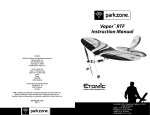
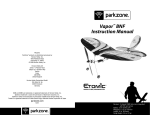

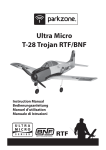

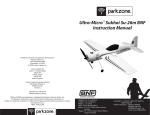
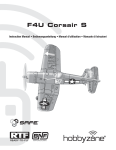

![Minium Citabria_P001 [Konvertiert]](http://vs1.manualzilla.com/store/data/006585447_3-fe7b6db82b655e204f379c9d210cf94d-150x150.png)
